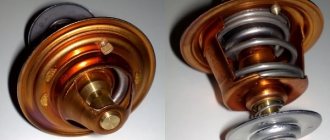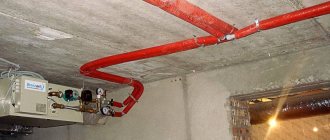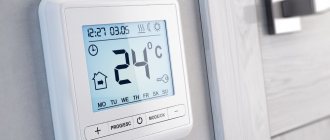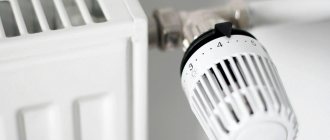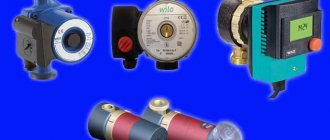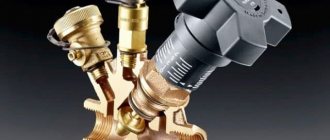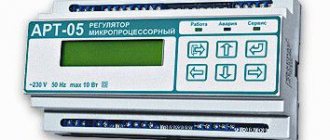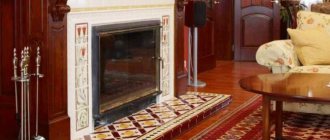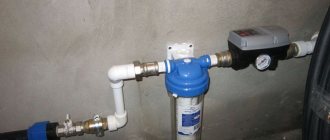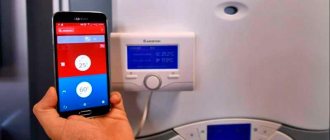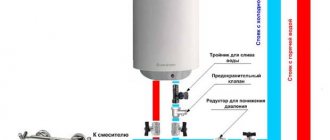Connecting and setting up a capillary thermostat
Finally, we come to the most interesting thermostat. It is interesting to us as ventilation engineers, as it provides one of the protections against freezing of the water heater. It’s worth saying right away that the capillary thermostat is not only Danfoss. There are other manufacturers, there are many of them, it’s just easier to show one, the principle of operation is similar for all, as is the appearance and installation method.
Figure 9.1 - Danfoss KP61, inscription on the packaging.
We remove information from the packaging - this sensor controls the temperature from -30 to 15 degrees. Thermostat hysteresis is adjustable. In our case, this is apparently 1.5 – 7 degrees. The length of the sensitive element is 5 meters. The length of the element is important because, ideally, the element should extend across the entire surface of the heater. Sensors are produced with different lengths of these elements; when ordering, be sure to specify and pay attention to this! A sensor that is too short will not cover the entire heater, which will worsen the protection, and a sensor that is too long is more expensive, it can be mounted, but here you need to look at the economic feasibility. Installation examples are shown in Figures 9.13, 9.15. 9.16, 9.17. And in principle, we are not engaged in design here. You already have a ready-made, designed ventilation unit. If your sensor fails, for example, it was damaged during installation, be guided by the situation. The sensor fits the heater normally - take the same one. If you are not satisfied with the length, take it according to the situation.
Figure 9.2 - Danfoss KP61, general view.
Here it is, this most sensitive element, below in the photo. When installing it, it must be CAREFULLY and CAREFULLY unscrewed at the surface of the heater as shown in Figure 9.13. If you bend the tube to the point of breaking, the sensor will fail. This will manifest itself in the fact that the contacts will not change their position. They will freeze forever. The installer can hide this sin by connecting the wires in such a way that your system controller will think that everything is fine. The adjuster may miss this. If you operate a ventilation unit, do not take anyone’s word for it, check its serviceability yourself. How to do this - there are several options. You can throw snow on the capillary while working. This will require turning on the unit with the ventilation unit cover removed. Be careful that nothing or anyone gets sucked in there. You can turn off the hot water supply. Either with a tap, which should be on the mixing unit, or manually, controlling the position of the drive from the controller, or again manually, some drives allow this. But with this method, be EXTREMELY CAREFUL so as not to actually freeze the heater! It is best to do this when the outside temperature is just above zero. At the same time, monitor the return water temperature and the supply air temperature. At the same time, you can also check the operation of the low return water temperature, if your system has such protection. To find out if it exists, READ THE MANUFACTURER'S INSTRUCTIONS!
Figure 9.3 - Danfoss KP61, view with the protective cover removed.
Figure 9.4 - Danfoss KP61, view without cover, at an angle.
How to set the temperature. Rotate the adjustment knob and follow the pointer on the scale. Danfoss is a little confused in this regard, as it has a protective locking bar. To make adjustments it must be removed. Pay attention to Figure 9.12. in the photo below this bar is visible immediately below the handle. Next to the handle there is a golden hexagon. This is the hysteresis setting knob. I hope you remember from the previous pages what it is? It sets the difference in temperature at which the sensor contacts will return to their original state after reaching the target. To set the hysteresis, you need to remove the handle and rearrange it, as shown in Figure 9.12.
I do not recommend setting the temperature below 5 degrees. Higher - please, but make sure that there are no false positives. Usually set from 5 to 10 degrees.
Figure 9.5 - Danfoss KP61, adjustment knob and scale.
Figure 9.6 - Danfoss KP61, adjustment panel.
Figure 9.7 - Danfoss KP61, temperature and hysteresis setting scale.
Figure 9.8 - Danfoss KP61, view with closed terminal block.
Figure 9.9 - Danfoss KP61, view with open terminal block.
Figure 9.10 - Danfoss KP61, terminal block.
Figure 9.11 - Danfoss KP61, instructions.
Figure 9.12 - Danfoss KP61, how to set the temperature and thermostat hysteresis.
- capillary;
- mounting bracket;
- thermostat;
- inlet of hot (direct) water into the heater;
- ventilation system unit with water heater;
- outlet of cooled water (return) from the heater;
- non-opening panel.
Figure 9.13 – Installation of a capillary thermostat.
When installing, pay attention to where to place the thermostat. Try to place it on a part of the ventilation system that most likely will not open. You should not place it on the casing that covers the water heater. It can be retrieved for some service purposes. It is dangerous to dismantle and install this thermostat again; you can damage the capillary tube.
Figure 9.14 – Capillary thermostat PolarBear PBFP 6N complete with mounting brackets.
Take a look at another capillary thermostat, made by Polar Bear. Called PBFP 6N. The number 6 in the name of the thermostat characterizes the length of the capillary tube. Here it is 6 meters. This thermostat is also interesting in that it comes immediately complete with brackets for mounting the capillary tube, which are shown in position 2 of Figure 9.13. In Figure 9.14, these staples are visible on the left side of the photo, they are black and packaged in a plastic bag. For other thermostats, please note that brackets may be sold separately. When purchasing, check to see if they are included or if they must be ordered separately.
Figure 9.15 – Example of mounting a PBFP sensor with a sensing element that is too long.
Figure 9.15 shows that it was possible to install a thermostat with half the size of the sensitive element. With the same heater protection, the sensor would cost less. However, the installation itself was very well done. Pay attention to the left side of the picture. Do you see the white screed? This is a fastening of the free end of the capillary so that it does not rattle when the fan is operating.
Figure 9.16 – Example of mounting a PBFP sensor, mounting the housing.
Figure 9.16 shows how it was decided to fasten the sensor body, the fastening of the sensitive element of which is shown in Figure 9.15. The sensor is next to the “direct water” input, in the upper left part of the photo. The capillary here is protected by a flexible tube from a set of differential pressure sensors. The solution is not bad, but the bad thing is that it results in a rather extended section of the capillary outside the heater zone. It is better to introduce the capillary into the installation as early as possible; an example of this option is shown in Figure 9.17.
Figure 9.17 – Example of mounting a PBFP sensor.
Figure 9.17 shows an option with a good introduction of the capillary into the installation, without extended sections outside. Disadvantages:
- the free end of the capillary is not secured and will dangle during operation, causing rattling, as well as the possibility of damage to the capillary;
- — the “snake” of the capillary is uneven on the surface of the heater, compare it with the option in Figure 9.15. Here the lower and upper brackets (2 and 3, if you count from either side) could be moved a little to the right.
Source
Types and characteristics of thermostats
A thermostat is a device that allows you to record the temperature in a room at a certain time interval and at the same time adjust the device settings to the required values. For example, when the temperature reaches a certain figure, the heating forcibly ends the operation cycle. And, conversely, with its decrease, the device resumes its operation.
The design characteristics and operating principle of thermostats may be different. There are two main types of thermostats for heaters:
To create comfort inside a living space, there are many devices, including various devices that take on the function of regulating the temperature of water or ambient air. This type of device includes a thermostat; this product is designed, after setting, to independently maintain the temperature of a heater or other heating element by turning the electrical power on and off. This article discusses the question of how to connect a thermostat, and also provides a diagram of connecting the controller to a heated floor system.
Connection and adjustment
If, after diagnosing the water heater, you find that the thermostat is faulty, you should replace this device with a new one. It is quite possible to do this on your own.
- Disconnect the water heater from the power supply.
- We block the water supply to the boiler and drain the remaining liquid from the tank.
- We remove the bottom panel of the device, opening access to the heating element.
- Remove the pressure ring of the heating element.
- We take out the thermostat sensors and the control unit.
- We install the new thermostat in place.
- We return the heater pressure ring to its place and secure the bottom panel.
- When going to the store to buy a new device, take the technical data sheet of the water heater with you. Knowing the necessary parameters, the seller will be able to select the appropriate thermostat model.
- Don't rush to throw away your broken thermostat before you get a new one. The marking on an outdated device is useful information, knowing which you can easily choose a new, identical thermostat, simply by showing it to the seller, or by entering it into the search bar of an online catalog.
If you choose a thermostat yourself, focus on the following characteristics: type of device, dimensions, installation method, operating current, functionality (temperature control and/or protection).
Types of thermostats
There are two main types of thermostats, which differ depending on the principle of operation:
- Mechanical devices are thermostats that regulate the temperature of the actuator by opening the contact between two plates of different densities. When the sensor heats up, the signal enters the contactor body and transmits a pulse to open or close the plates;
- Electronic thermostat. In this case, the information coming from the temperature sensor is analyzed in a digital processor, only after which the command to supply power to the heating element is executed.
In both cases, control is carried out manually, by setting the required temperature on the controller body. You can also classify thermostats based on visualization and control keys. Thermostats come with rotating dials, adjustment buttons or a touch screen. The operating principle of all of the listed products does not differ significantly from each other.
There is also a classification of thermostats by type of placement: external or internal. Depending on the task being solved, the device can be installed in a wall in a pre-made niche. The construction size of such a device coincides with an ordinary socket, so it is often mounted in a hole cut with a crown.
An externally located thermostat has a thicker body, which is covered on all sides with plastic plates. The downside of such a device is its size; due to the impossibility of placing the device inside the wall, it will protrude on the plane; in addition, when connecting a cable to it, you will have to create an additional channel from a corrugated pipe or pencil case.
Operating principle of capillary thermostats
The operation of a capillary thermostat is based on the first law of thermodynamics, which states that when the temperature in a thermodynamic system changes, it performs mechanical work until it reaches an equilibrium state. The design of the capillary thermostat allows you to control the temperature by regulating the value of the equilibrium point and includes the following elements:
- sensor in the form of a metal capsule containing working fluid;
- capillary connecting the sensor to the thermostat control unit;
- a control unit or an electromechanical relay, through which the required parameters are set (the equilibrium point is established).
When the sensor heats up, the contents of the capsule expand, which exerts pressure on the relay membrane through the capillary tube, and when the set temperature is reached, the contacts open. The typical error of such a device is ±3-4°C. This type of control devices, such as capillary temperature controller , is very simple, reliable and energy-independent, due to which it is used in a variety of equipment.
Areas of application of thermostats
Thermostats are widely used in various fields, both in industry and in everyday life. Most often, these devices can be found in underfloor heating systems with a heating element in the form of a heating cable, which is located in the screed. When power is supplied to the electrodes, the wires heat up and give off heat to all surrounding layers; for proper operation, the system is equipped with a temperature sensor built into the screed. The controller can be used for electric or water heated floors, the principle of its operation does not change.
The thermostat is also used in heating or heating boilers to automatically adjust the heating level of the internal environment. Many manufacturers equip heating devices with these devices already at the manufacturing stage, but even if the boiler design does not provide for this, you can install the controller on the line yourself.
Mercury thermostats
They are one of the very first types of devices and are not currently used (due to the toxicity of mercury).
There are two principles of operation of the product:
- mercury, having risen to a designated height in a thermometric vessel, closes electrical contacts or affects some device. The accuracy of such a thermostat reached 0.01°C, so it was used mainly in industrial conditions,
- a mercury sensor mounted on a bimetallic element, which, when the temperature changes, changes its position or configuration and activates the mercury mechanism. The accuracy depends on the accuracy of the bimetallic element and reached 0.5°C. The device was used both in industrial and domestic conditions./li>
The figure shows the device of a mercury thermostat. The flask with mercury is attached to a bimetallic element that reacts to temperature and tilts the flask in one direction or another. When the bulb is tilted to one side, the contacts close, and when the bulb tilts in the other direction, the contacts open.
Connecting the thermostat
Since thermostats can be used both to control heating elements and control the cooler, the device has two types of contacts and terminals. When connecting the device to the system yourself, you must strictly observe the polarity of the contacts and avoid contradictions in the circuit.
No electrical connection is required to connect a mechanical thermostat, since all control and opening of the switch is accomplished by physically changing the characteristics of the heating plate. To connect this device you need to follow the algorithm below:
- In the documentation for the devices there is a designation of the terminals by numbers; in accordance with these indicators, it is necessary to assemble the system. First of all, you need to connect the neutral cable to the electrodes of the box and take it directly to the consumed heating elements, for example, a heated floor;
- The phase is supplied to the controller directly, without connecting to household appliances. The box itself will distribute electricity when the contacts are turned on. In some devices, it is necessary to lay a jumper inside the thermostat from the positive wire to the operation indicator, which shows a signal at the moment the heater is turned on and throughout the entire period of operation;
- The control device contains terminals for connecting a cooling heating element, as well as for an external temperature sensor. All devices must be connected in series, and the current must be turned off completely. This is a typical connection diagram for a thermostat, which is most common in underfloor heating or infrared heating systems;
- The temperature sensor is connected last, after which a test run of the system is performed and the voltage on all elements is checked.
There is also a diagram for connecting a thermostat using a magnetic circuit breaker; most often, this scheme is used when there are several controlled devices that require high voltage current for operation. In this case, the machine is connected to an open network of the positive cable in parallel with the thermostat; in addition, there is a connecting cable with the control device. Current is supplied to consuming devices through a circuit breaker, but it is controlled by a thermostat. The heating elements are connected to the controller only on a parallel line and through an automatic machine, this allows the system to operate with high voltage without interruption and in a safe mode. In the event of an emergency, the switch will operate and completely de-energize all devices.
Thus, it is clear from the diagram that the thermostat is connected to heating or cooling devices immediately before voltage is applied to them, that is, the controller will be the first element in the system. Many thermostats are equipped with an electronic chip and processor, which, in addition to temperature indicators, provide additional data on various indicators, such as the state of humidity in the room, pressure and the time required to achieve the set parameters. Such devices have a much higher cost than mechanical thermostats for household use.
Connection options
- To the heated floor system;
- To the heating element;
- To the heater.
A standard underfloor heating thermostat is supplied with detailed instructions for connecting the device to the underfloor heating system. You can connect the TP yourself using the markings under the terminal blocks.
Underfloor heating mat
On the back of the regulator there are three pairs of terminal sockets for wires. The first pair is intended for connecting a two-core network cable. Socket “L” – phase, “N” – zero.
The second pair of sockets is intended for connection to the underfloor heating terminals – L1 and N1. The fifth and sixth terminals are used to connect to the temperature sensor.
Connecting the thermostat
Floor temperature regulators can be inserted into a socket box or mounted on the wall. The temperature sensor can be either built into the body of the device or installed at the end of an external cable.
In the first case, the air temperature inside the room is measured. In the second option, the sensor measures the degree of heating of the final floor covering.
The thermostat must be connected to the electric heater through a magnetic starter. This is due to the fact that the power of the regulator is far from comparable to the power of heating elements.
A magnetic starter (MP) is needed when the thermostat controls several heating devices at once. The MP is cut into the phase wire in parallel with the thermostat. Adjustment of the operating modes of the heaters is carried out by a thermostat, the supply current passes through the MP. This makes it possible to use a three-phase power supply, which allows the operation of high-power heating elements.
Many TRs are equipped with electronic microprocessors, which additionally provide indicators of the level of humidity, pressure and time required to achieve the values of the specified parameters.
Thermostats can be mechanical or electronic. Recently, the second models have been actively displacing their mechanical counterparts. The use of modern electronics makes it possible to more effectively control the temperature in a given environment.
TRs for room heaters are built into heater housings or placed away from heating devices. The regulator, first of all, is connected to the electrical network, then through the control circuit it is connected directly to the temperature sensor.
Additional Information. In most cases, infrared heaters are connected to a thermostat via a magnetic starter. To connect the device correctly, you must strictly follow the instructions provided.
Features of how temperature control devices are connected depend on the type of heating devices. This can be a single-core or two-core connection of TP underfloor heating. The connection of a two-phase thermostat to three-phase current heating elements is carried out only through a magnetic starter. For water heating, the thermostat is embedded directly into the radiator. Each specific case has its own thermostat connection diagram.
Connecting a thermostat to a heated floor system
Depending on the type of heating cable in the underfloor heating system, the connection diagram will be different. There are two types of flooring: with a single-core and two-core bundle, the principle of operation between them is similar, but a multi-core cable has a service life, as well as technical indicators for speed and heating height, much higher.
It is easier to connect a thermostat to a single-core system - just connect two neutral cables to one terminal, and the phase to the corresponding socket. In this case, the current will pass through the entire length sequentially along the ring of the bundle.
In a two-core cable, all wires come out from one side, so the connection is made in series - one wire to one terminal. The current in this scheme passes along the entire length of the heating element and returns along the same path in one direction.
Thus, if you follow all the rules and the algorithm for connecting the thermostat to any circuit, all that remains is to adjust the device to the desired parameters by rotating the wheel on the temperature scale.
Video
If you have an infrared heater at home, then a thermostat is a must. The thermostat is capable of controlling and maintaining set temperature values for a long time. In addition, it will allow you to warm up the rooms in advance, reduce the risk of fire and make the atmosphere in your home as comfortable as possible. To understand the intricacies of connecting a thermostat to an infrared heater, we will first look at the principle of its operation, the mechanism of operation and highlight the main types of thermostats.
Typically, the thermostat operates cyclically
, in this case the electrical network opens and closes. At this time, the temperature sensor sends signals and thereby regulates the temperature.
Principle of operation
Most often, temperature sensors operate cyclically, and at the same time, an electrical circuit opens and closes. As the temperature increases, the resistance of the internal thermostat sensor drops. As soon as the specified parameter is reached, the device is triggered and turns off the circuit. When the temperature decreases, the reverse process occurs - the resistance increases, and as a result, the thermostat turns on the electrical circuit.
Using a temperature sensor, you can easily control the indoor climate. You just need to set the desired temperature in the apartment, after which the device will do everything on its own. Infrared heated floors have now appeared on the market.
, which are capable of heating not only the air, but also surrounding objects. For the system to operate in automatic mode, a thermostat must be connected to it.
In this video you will learn how to connect a thermostat:
Thermostat for water heater
The thermostat ensures safe operation of the water heater. This process is explained as follows: when the water temperature rises, the pressure inside the tank, which is sealed, increases.
When the pressure increase is not controlled, the entire structure will explode
, which is dangerous not only for equipment and surrounding objects, but also for human health if a person is nearby during the explosion.
The thermostat allows you to maintain the temperature at the required level. Bottom line: the temperature regulator protects against explosion and overheating
, damage to equipment and property, ensures the safety of people.
Most manufacturers try to equip the boiler with a thermostat, because it is the one that controls water heating
at the moment when the device is connected, and for timely blocking of the heating element.
a wide range of models on the market
, but the principle of operation is the same for all of them. At the moment when you need to connect the device to the network, you need to immediately adjust the water heating level, which is done using the control panel, which is located on the body.
Next you need to adjust the water heating. The relay that is installed on the thermostat will be responsible for opening the contacts of the heating element. When the tank has completely cooled down, the temperature will drop and become lower than normal. At this moment the contacts will close
The heating element of the relay, due to which the system will start again and the liquid in the tank will begin to heat up again.
Main types
All modern thermostats work on the same principle. However, there are quite a lot of differences between them that affect the device settings, control and connection diagram of the temperature sensor.
Mechanical thermostats are characterized by ease of operation and high reliability. They are a plastic box
equipped with a lever to control the room temperature. To simplify the setup process, the devices have a scale with divisions, the standard step of which is 1 degree.
If previously mechanical thermostats were often used to control electric heated floors, then they are not very well suited for working with infrared heating systems. However, if desired, they can be connected quite easily. Although many people prefer electronic devices, mechanical ones continue to be used. This is due to the simplicity of their design, as well as their long service life.
The peculiarity of electronic temperature sensors is the presence of a display to display all the information important for setting. If a mechanical thermostat does not require electricity to operate, then an electronic one must be connected to the network. The control panel, depending on the model, can be touch-sensitive or push-button. Some devices provide the ability to program the temperature for a certain period of time, for example, a week.
Advanced models can even be controlled using a smartphone if the appropriate application has been installed on it. Electronic temperature sensors have gained popularity primarily due to their ease of use. However, their cost is higher compared to mechanical devices.
To increase the service life of the electronic temperature sensor, it is not recommended to install it in drafty areas or in places where there is active exposure to direct sunlight. Thanks to a simple thermostat connection diagram, almost any home DIYer can handle this job. However, first you need to decide on the connection method:
- Classical.
- Using a magnetic starter.
Both options are worth considering in detail.
Standard scheme
One of the important parameters of any thermostat is the power indicator. One device can be used to control several room heating devices. The number of heating devices that can be connected to it depends on the power of the thermostat. At home, it is quite enough to use devices with a power of no more than 3 kW.
There are 2 ways to connect these sensors
Most often thermostats have four contacts
- two for entry and exit. To connect the device, you need to stretch two conductors from the junction box and connect them to the input terminals. After this, the output contacts are connected to the heating system using two other wires.
If there is a need to connect two heating devices to the thermostat at once, then you need to decide on the type of connection:
In the first case, it is necessary to stretch two conductors from the output terminals of the thermostat to the first heater, and two more from it to the next one. When connected in parallel, four conductors should be drawn from the input contacts of the temperature sensor - two for each heating device.
Using a magnetic starter
This connection diagram for a mechanical thermostat is most often used to control several heaters. A magnetic starter is an electromagnetic type switching device. It is designed for use in networks with high loads. There are quite a few options for connecting a thermostat via a magnetic starter, but a home master only needs to know one.
At the first stage of the work, it is necessary to connect the regulator to the electrical network using two conductors, using the input terminals for this. Then the output contacts of the temperature sensor are connected to the starter, and it is already connected to the heater.
If everything was done correctly, then all that remains is to configure the regulator to the desired operating mode. Connecting the thermostat should not be difficult if you follow the instructions. However, you should not overestimate your strength, because the safety of family members depends on the quality of the connection.
Source
Kinds
Thermostats that water heaters are equipped with come in several varieties - rod, capillary and electronic. Let's look at each of them in more detail.
Rod
Rod thermostats are perhaps the oldest of all such devices. They are a small tube approximately 35 cm long and 1 cm wide. Under the influence of high temperature, the tube increases in size and presses on the switch. The disadvantage of such a system is its low accuracy, since the tube can quickly cool down, causing the boiler to work longer than necessary.
Capillary
Capillary thermostats appeared later than rod thermostats, but they have also been used for quite a long time. They are also made in the form of a tube, but inside there are cylinders with a liquid whose density is different than that of ordinary water. When heating occurs, the liquid increases in volume and the cylinder comes into contact with the membrane, which turns off the device. The accuracy of this type of thermostat is +/- 3 degrees.
Electronic
Electronic thermostats are the most modern and accurate of all of the above. For more advanced operation, they interact with a protection relay, which allows emergency power shutdown if the water heater tank is empty.
There is another classification of thermostats, according to which these devices are divided into the following types:
- electromechanical/electronic
– depending on the key control element; - simple/programmable
- depending on the method of setting the temperature; - overhead/mortise
– depending on the installation method.
